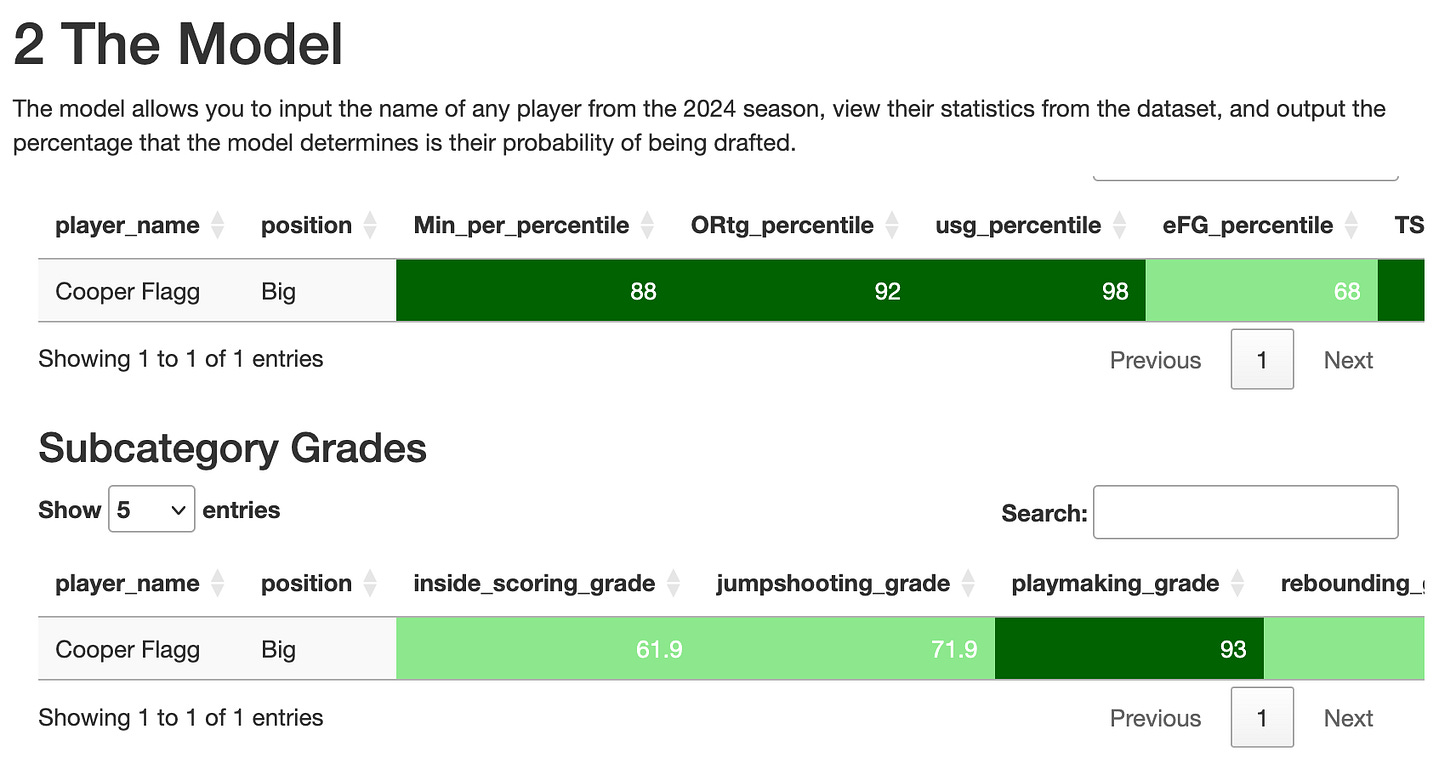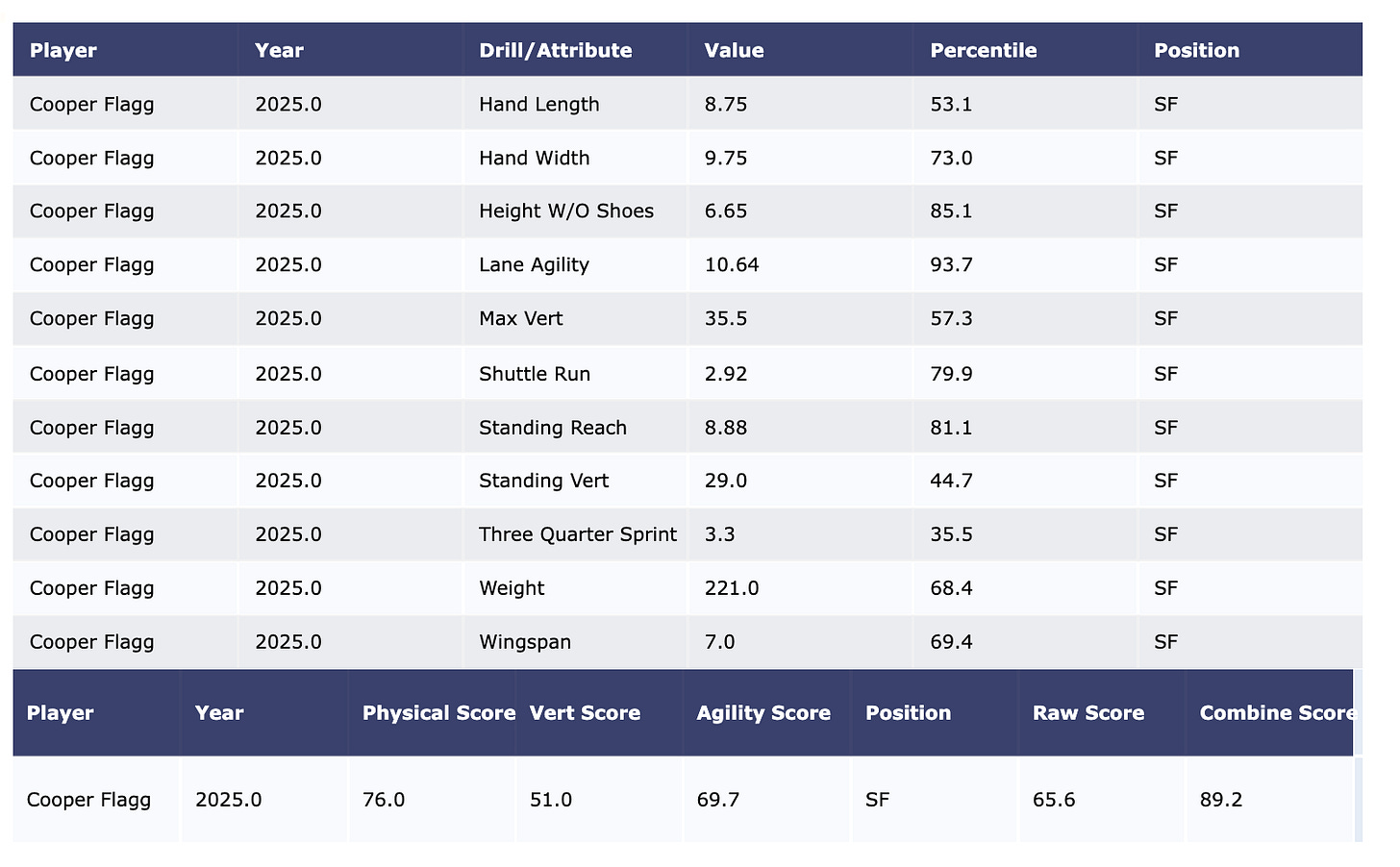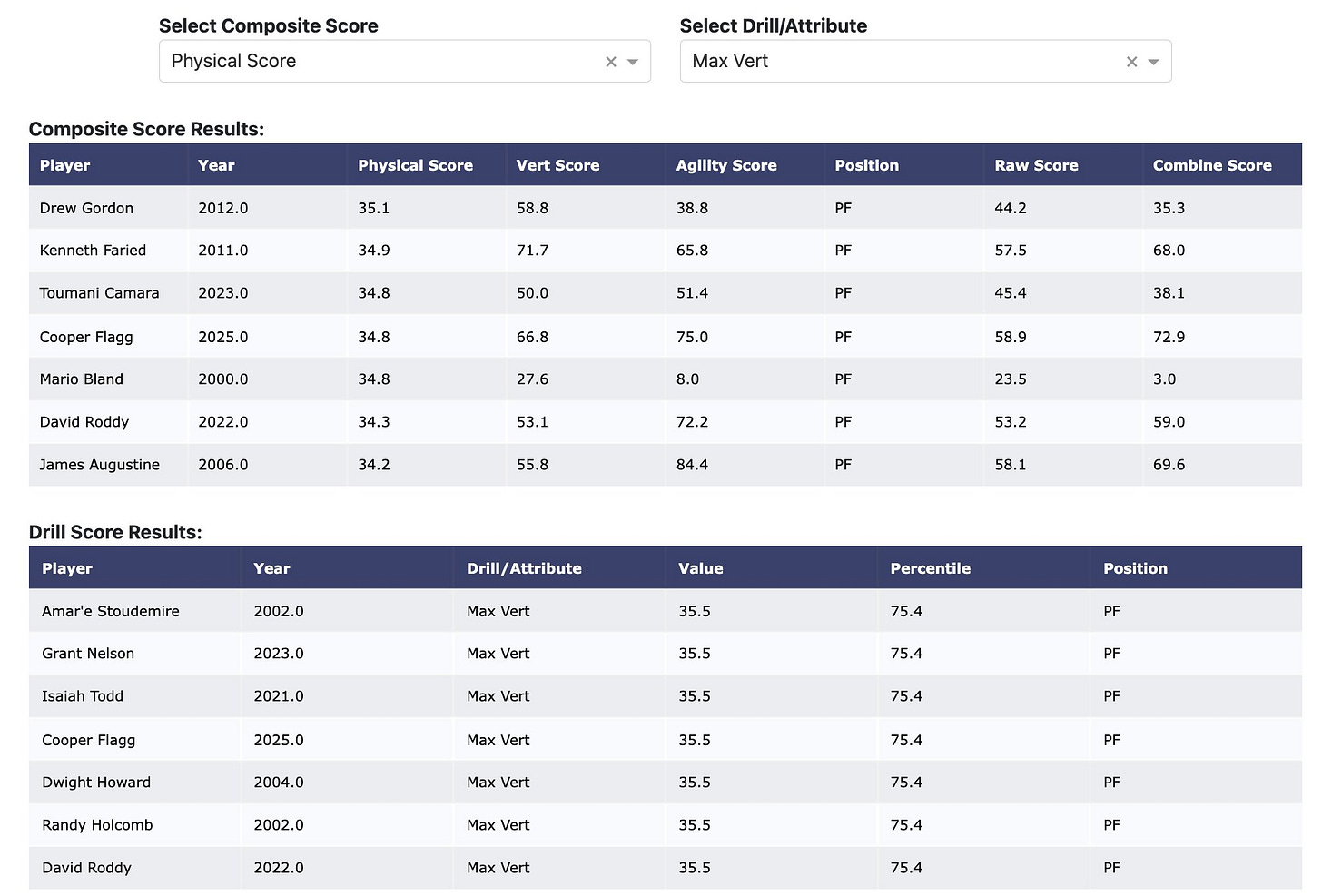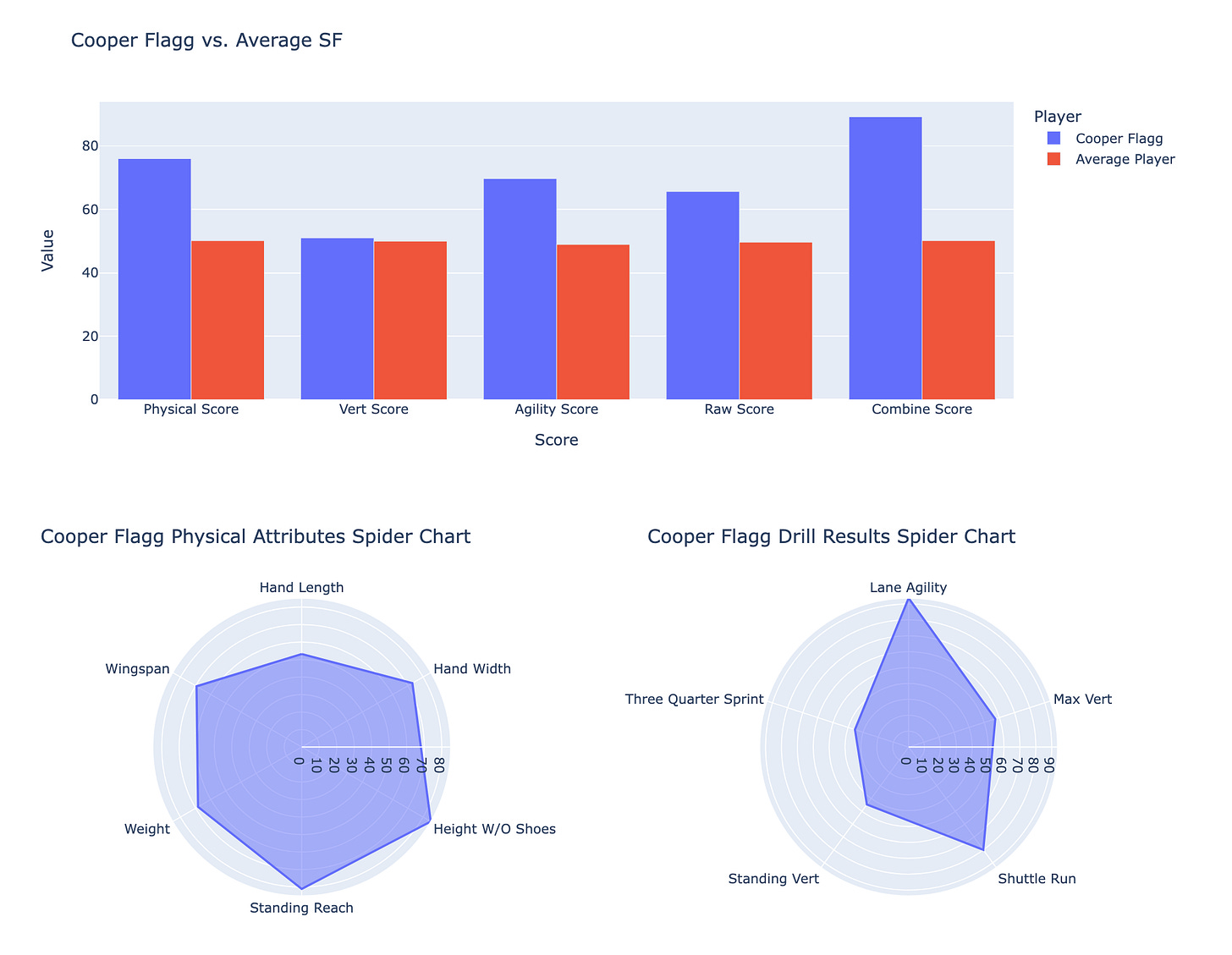Draft Data Deep Dive, Part I: The Cooper Flagg Comparisons You Haven’t Heard Yet
Let’s talk data, models, and other insights on the prodigy prospect
This is part of my offseason deep-dive series. The content comes less frequently than the game-by-game coverage during the season, but with more time spent on data and analysis, each piece aims to be more in-depth, longer, and more meaningful.
We started with the NBA Trends Series, which will continue in the coming weeks. But with the growing appeal and intrigue around Cooper Flagg, the projected number one pick in the upcoming draft where the Mavericks have the first selection, it was time to dig into the draft as well.
Thanks to everyone who sent in questions through the chat thread. Based on your questions and a few of my own, I’ve decided to split this into two parts. Part I focuses on Flagg. Part II will take a closer look at the Lakers’ situation and potential late-draft options — especially athletic wings and point-of-attack defenders.
I’m not a draft expert, and I don’t watch much NCAA. There just isn’t enough time when following the NBA closely, especially last season when I was tracking both Mavericks and Lakers games after the deadline. What I can do is dive into the data and film to look for comparisons and patterns. That approach shaped my optimism about Dereck Lively II and my skepticism around Olivier-Maxence Prosper after the 2023 draft.
Even better, when I notice interesting signals or comps, I can reach out to people who follow prospects more closely. For this series and Q&A, I connected with Nick Kalinowski, a data scientist who covers the NBA Draft and creates scouting reports, breakdowns, and big boards. You’ll find a detailed Q&A with Nick, along with references to his work, models, and other intriguing insights in the final section of this deep-dive.
Today’s highlights:
Cooper Flagg’s two-way promise, breaking the mold. And the comps.
My comparisons based on historical college stats
Cooper Flagg Q&A with Nick Kalinowski
1–Cooper Flagg’s two-way promise, breaking the mold. And the comps.
Even if you haven’t watched a minute of Cooper Flagg play basketball, the hype and comparisons from the last couple of weeks make it hard not to feel truly excited. Best college prospect since Zion Williamson. Best freshman player Duke has ever had. Those are two bold declarations from two of the most respected voices in the draft world — Jonathan Givony and Jay Bilas.
And some of the comparisons have been even more grandiose, making Mavericks fans rightfully question their team’s ceiling next season and whether they should shift from a win-now approach to rebuilding the roster around Flagg. I’ve seen ESPN compare him to Kawhi Leonard, Scottie Pippen, Jayson Tatum, Lamar Odom, and Andrei Kirilenko, while my friend Isaac Harris in Dallas even sees him as the next Kevin Garnett.
Flagg himself has set the bar high, saying he models his game after Jayson Tatum on offense and Jonathan Isaac on defense. If you could actually combine those two, you’d have an elite two-way force and possibly the best player in the NBA. Speaking of models, Zion Williamson, Anthony Davis, and Luka Dončić are the only three prospects who ranked ahead of Flagg in Kevin Pelton’s statistical projections for ESPN.
So I’m not breaking any news by saying Flagg will be good. The real question everyone is asking is just how historically good he might be.
2-My comparisons based on historical college stats
By now, you can see that Flagg is such an intriguing prospect and difficult to compare because of his two-way potential and skill set. That’s why names like Leonard and Garnett come up. But even Kawhi wasn’t nearly the passer or high-usage scorer Flagg is at such a young age. Because of that, I split my comparisons into two groups of players: one for offense and one for defense.
Defense
First, it’s really hard to find a college prospect who matches Flagg’s combination of block rate, steal rate, defensive rebound rate, and defensive win share rate.
I don’t necessarily think Flagg will reach the same level of defensive impact as Anthony Davis, Kevin Garnett, or other anchor big types — or even Jonathan Isaac, who is truly elite when healthy. That’s mostly because those players have clear advantages in size and length. Draymond Green is another interesting comparison, partly due to the playmaking element, but he’s also a one-of-a-kind, high-IQ defender who’s tough to replicate.
Maybe Flagg’s competitiveness will help him become one of the best defenders in the league, but that’s hard to project. He’s also not the same kind of on-ball menace that someone like Toumani Camara or peak Ben Simmons was. However, even if his defensive ceiling ends up closer to that of a secondary rim protector and roamer — someone like Tari Eason, a comparison I personally like — that would still make him a very good, All-Defense caliber defender.
Offense
If it’s hard to find comparisons that match Flagg’s rebounding, block, and steal rates, finding a forward with similar scoring, usage, and assist rates might be an even tougher job.
If you filter college stats for players with Flagg’s combination of scoring (over 20 points per 36), assists (over 4 per 36), usage rate (above 25%), and more than 100 three-point attempts in a season, you won’t find wings. Instead, you’ll mostly see high-usage scoring primary playmaking options like Stephen Curry, Kemba Walker, Damian Lillard, and Ja Morant.
A few interesting secondary playmaking wings that showed up in my comparisons once I lowered the thresholds were the previously mentioned Draymond Green and Ben Simmons, along with Evan Turner and Kyle Anderson. We’ll see whether Flagg develops more as a scorer — like Kawhi Leonard, Jayson Tatum, or Paul George — or as a playmaker in the mold of Draymond Green or Ben Simmons. The potential and uncertainty is what makes watching his career path unfold so intriguing.
Nick shared his thoughts on that, along with Flagg’s potential to help fill some of the Mavericks’ playmaking gaps, in the next section.
3-Cooper Flagg Q&A with Nick Kalinowski
Here’s the first part of my Q&A with Nick Kalinowski, where we talked about his draft evaluation process, Cooper Flagg comparisons, concerns and your questions about Flagg’s playmaking and potential fit in Dallas.
Q: Can you provide a brief intro or background about you and your work?
Nick: I’ve always been into basketball. I played throughout my childhood, but I was never good enough to go anywhere as a player. So I started looking for other ways to apply my skill set to the game I love. In 2023, I began a master’s program and spent the year applying everything I learned to a basketball dataset, which I started posting online. That eventually grew into a full-time side project, and I’ve been enjoying it ever since.
Q: What goes into your models and projections?
Nick: My draft model uses over 500 unique variables to project a player’s NBA performance. These include standard box score stats, biometric data, Combine measurements, Synergy play type breakdowns (like pick-and-roll ball handler, halfcourt vs. transition), and even mock draft projections. This data is collected for every player going back to around 2010, and fed into a machine learning model, which learns the important variables that translate to better NBA production.
Q: One of our readers asked about Combine measurements. I saw you’re doing Combine Scores — how do they work, and how helpful or telling are they for future NBA fit and performance?
Nick: Combine Score is a metric I developed as a one-size-fits-all measurement of a player’s athleticism, relative to others at their position. It works by comparing a prospect’s performance in every combine drill to players of the past, and getting the percentile value for where they stand historically. Then, these percentiles are aggregated into three separate categories: Physical (height, weight, wingspan, etc), Vertical (max vert, standing vert), and Agility (pro lane drill, shuttle run, etc).
The average of the Physical, Vert, and Agility values is the final Combine Score. In general, players with a higher Combine Score tend to have better rates of being selected in the draft, and first round picks for 4 out of the 5 positions (except center) have significantly higher Combine Score values than second rounders.
EDIT: Flagg scoree an 89.2 as a small forward and 72.8 as a power forward based on Nick’s Combine Score metric. Here’s a great thread from Nick breaking down how his Combine Score metric relates to draft outcomes by position.
Q: How comparable are your projections with other models like Kevin Pelton’s WARP projections?
Nick: I’ve only had my overall draft model for one year, but initial results are promising. This past draft class, eventual Rookie of the Year Stephon Castle was my model’s highest graded NCAA prospect, followed closely by other rookie standouts like Jared McCain and Zach Edey. Likewise, internationally, first team All-Rookie big Alex Sarr led the pack. While there were some definite misses (Jaylen Wells being the biggest), the projections indicate a relatively high degree of predictive power, and can only improve with more data.
Q: The question with Flagg isn’t whether he’ll be good or even a superstar — or is it? It seems the real question is how great he can be. I’ve seen comparisons ranging from Kirilenko and Odom to Paul George, and even Kawhi Leonard, Scottie Pippen, and Kevin Garnett. How do you see Flagg’s potential ceiling?
Nick: Flagg projects as a combo forward who is a great athlete and can act as a secondary playmaker right away, along with being a capable shooter. Lamar Odom is a pretty close comparison to his offensive game in that regard, with the upside to becoming a menacing defender. Athletically, he graded out as above average for the position, with his overall athletic profile comparing well to Kenneth Faried, a player well known for powerful displays of strength and leaping ability. Right now, the jumpshot is still generally inconsistent, but in the “ceiling” scenario he becomes at least a league-average three point shooter (35% or so). Odom’s initiation and secondary playmaking + above average defense + Faried’s athleticism + capable jumpshooter is a scary thought for the rest of the league.
Q: What would you say is your biggest concern with Cooper Flagg?
Nick: It took a while for Flagg to get going as a shooter at Duke, and I expect that it’ll take a similar, if not longer, adjustment period at the NBA level. While he is excellent at getting to the basket, those lanes will continue to be clogged until he demonstrates a consistent outside shooting threat, which may dampen his offensive numbers. My worry is that the mental aspect of missed jumpers + tougher finishes will adjust his playstyle negatively.
Q: Based on my simple past stats comparisons, players like Ben Simmons, Draymond Green, Evan Turner, and Kyle Anderson show up as similar forwards with high-usage, playmaking profiles. To be a bit provocative — is there a chance Flagg ends up more like Turner or Simmons at the NBA level?
Nick: He doesn’t project as an oversized point guard like either of those players, moreso a secondary playmaker who can operate alongside a primary point guard (like Kyrie), and create chances in the halfcourt. In that sense he fits more of the Draymond/Anderson role.
Q (fom a Mavericks reader): It seems Flagg will start his NBA career at small forward, playing alongside Anthony Davis and Dereck Lively II. Do you see any potential issues with that fit, particularly when it comes to spacing?
Nick: It’s certainly possible, especially with the aforementioned shooting struggles that I anticipate he’ll have early on in his career. The ideal solution to me would be to have Cooper at the 3, a more potent shooting threat at the 4, and Davis/Lively as the center.
Q: With Kyrie’s injury, Dallas is short on playmaking — and we’ll see if they add more guards in the offseason. How do you see Flagg as a playmaker and on-ball creator for himself and others in his rookie season?
Nick: Flagg is a productive self-creator who usually makes good reads in the halfcourt. His potency as a slasher forces defenders to play him loosely from beyond the arc, which opens up a plethora of jumpshot opportunities. When driving, he keeps his head up and is unafraid to pass up his own shot for an easier look for one of his teammates. Flagg and Maluach had a strong rapport on lobs off of Cooper’s drives, and I expect something similar to develop between him and one of Dallas’ dunker spot bigs (Lively or Gafford).
Q (fom a Mavericks reader): Is there a chance Cooper Flagg could follow a development path similar to Cade Cunningham over the past few years — evolving from a versatile point forward into a primary initiator, shot creator, and playmaker?
Nick: I don’t see him ever being the primary initiator for an offense, but that’s not necessarily a bad thing - he contributes in so many ways already as a playmaker. While becoming increasingly more frequent, forwards who act as the primary initiator for an offense are still quite rare in the NBA, and I would argue that a prospect has to be a generationally good playmaker (see LeBron, Jokic) to make that work full-time. Cunningham also operated as a point guard throughout his development cycle (high school, Oklahoma State, etc), so his path is also a bit different from Cooper’s.











Every time I’m reading (or listening) about Copper Flagg I get more excited. I just wish the Mavs have a new GM who can , objectively take a look at our roster and decide what to do. I’m ok with either direction, trade every older player, and do quick rebuild around CF (since we don’t control our picks from ‘27-‘30). Or find another ball handler and go for it.
Another great analysis Iztok with a perspective that is unique and different from other pre-draft reads!
I was just reading some other pre-draft articles and was reminded about Mavs picking Melvin Ajinça last year … have to admit in all that’s happened in Mavs world this year I have no idea how he’s progressed this year overseas and could he be ready to join Mavs and make an impact next year?